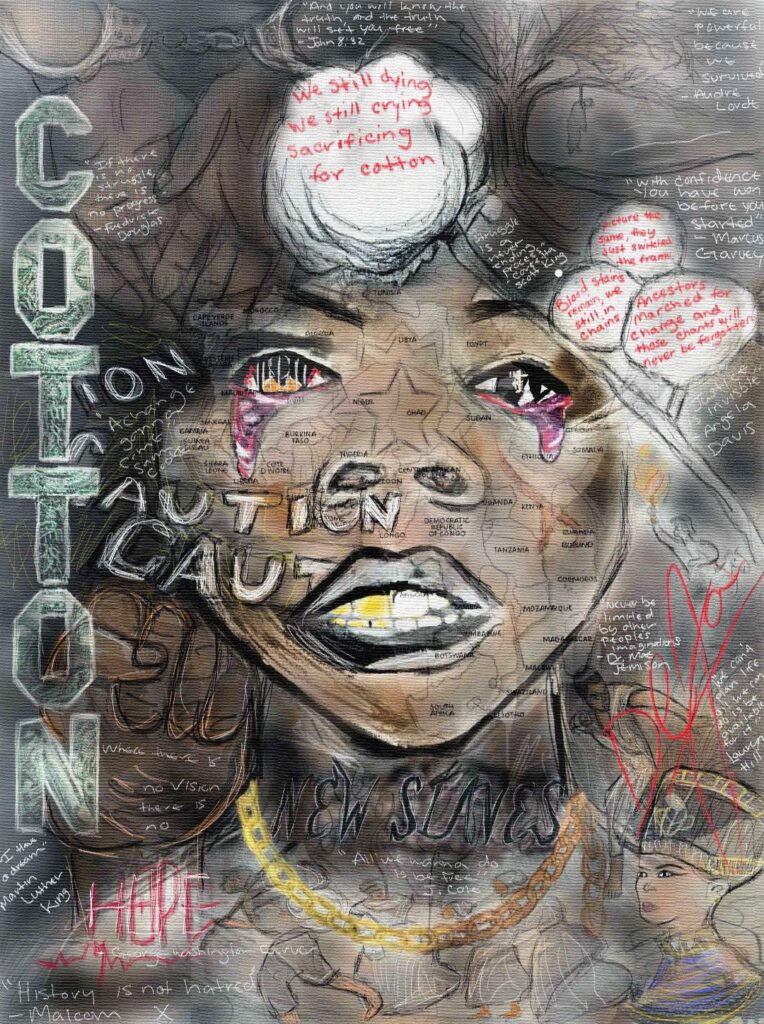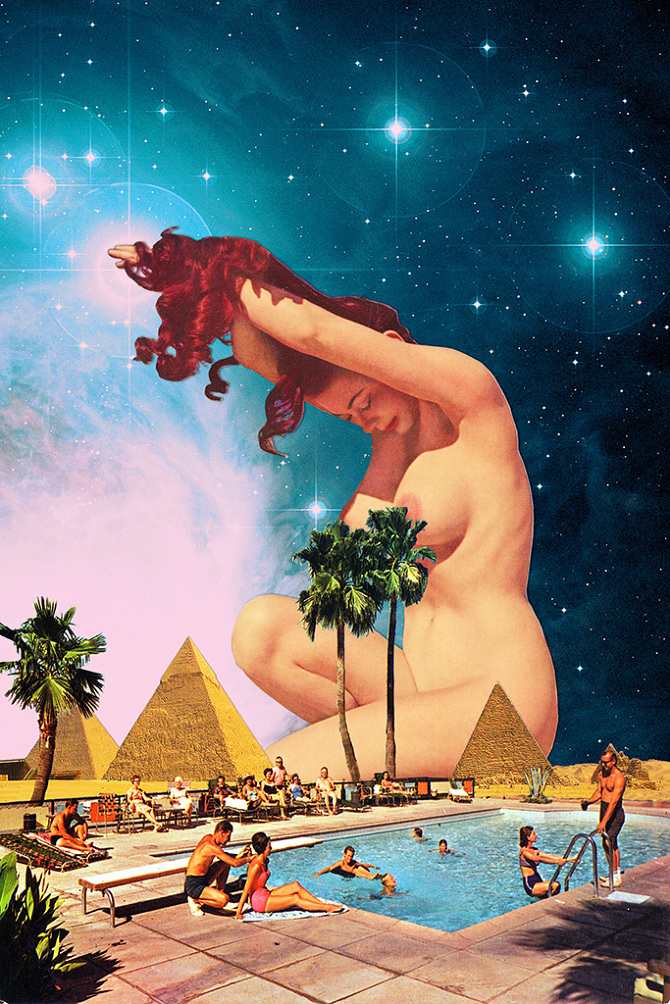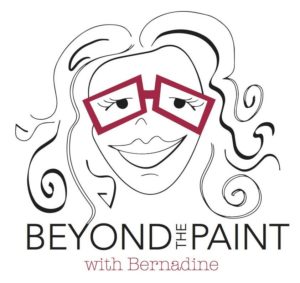In part 1 of my episode on Digital Art (#159), I explored digital art as a medium, and the ways artists use digital platforms from production to presentation. This included installation, video art, virtual reality and sound and music environments.
In part 2, I focus on two contemporary female artists working in Digital art; an emerging artist Ande Ja Johnson who employs the art tool Paint 3D app from Microsoft and the Digital collagist Eugenia Loli. This episode includes a conversation with the artist Ande Ja Johnson.
Resources for this episode include Museum of Modern Art, Metal magazine, the writer Harriet Baker and Eugenia Loli website. Loli’s IG handle is @eugnia_loli Ande Ja Johnson: IG handle: @ _dej_j Image credits: Eugenia Loli and Ande Ja Johnson




Script: Episode 161: Digital Art: Part 2
Hello my art enthusiasts: In part 1 of my episode on Digital Art (#159), I explored digital art as a medium, and the ways artists use digital platforms from production to presentation. This included installation, video art, virtual reality and sound and music environments. Today I want to focus on two contemporary female artists; an emerging artist Ande Ja Johnson who employs the art tool Paint 3D app from Microsoft and the Digital collagist Eugenia Loli.
Let’s journey through a fascinating portrait by Ande Ja Johnson, titled “Cotton.” It is composed of a young, black woman, front view. Her facial features are front and center in the work, dark almond-shaped eyes, a pool of tears form in rivulets down her cheek, full lips exposing her teeth, her expression is somewhat tense, her nostrils flare, her neck adorns a gold chain, surrounding the woman are multitude of images, closed fist, in the lower right corner an Egyptian Pharaoh’s wife, another set of hands, we see the back of two hands shackled by cuffs placed next to the top-left of the woman’s head. There are circles of white, one in the center of her forehead, a cluster of three on the right side of the canvas. There are quotes written in red. “We still dying We still crying, sacrificing for cotton blares the white puffy cloud atop her forehead. In graphic bold letters, the title Cotton, spelled out one letter atop another. The more you look, the more is revealed. A bare tree, its bare branches reach out against a dark sky, a figure is hanging by its neck, an execution. Across the female’s neck the works New Slaves; and in white script more quotes by famous African American social activists like Malcolm X “History is not hatred,” or Angela Davis who said “Justice is invisible.”
The work is powerful and engaging. I saw the work at a private elementary school where Johnson is an Art teacher. At first I thought it was composed by the media pen and ink, perhaps graphite and paint. The artist revealed she used Microsoft art tool, Paint 3D for Windows 11. For me who loves the materiality of paint or graphite or watercolor, I was really captured by this digital medium, and the materiality of the digital and the ways it is expressed. I asked Ande Ja more about the work, from conception to process, to finish. This is what she had to say.
Questions: As I shared in the introduction, I was very moved by the portrait “Cotton.” At first I thought the medium was graphite or pen and ink, and was curious that it was composed from a Microsoft art tool. Before we go into subject matter of your work “Cotton,” can you share for those who do not know, what is this tool? Why do you use it? Do you prefer it over a traditional medium like graphite, charcoal, etc. Why? What are the benefits of using digital tools like the Paint 3D for Windows, challenges? Can you share how you conceived the portrait “Cotton”? Is the portrait of the young woman a specific person or a culmination of women? What messages do you want the viewer to take away from your work? Share one or two of the symbols in the work as examples.
I hope De Jay enlightened you to her process, practice and her resonant work. One of the areas of digital world I find fascinating is Digital Collage. I am very passionate about collage as an artistic technique. Outside of the materiality of paint, I am very drawn to works composed from collage. It is very familiar term, but in the context of art history, let’s look at what defines “collage.” Derived from the French verb coller, meaning “to glue,” collage refers to both the technique and the resulting work of art in which fragments of paper and other materials such as painting, drawing and three-dimensional elements, are arranged and glued or otherwise affixed to a supporting surface. It was first used as an artists’ technique in the early 20th century. Pioneer of collage are the Cubists Picasso and Georges Braque. From the writer Harriet Baker, “collage allowed artists to interact with existing materials – anything from newsprint and magazines to maps, tickets and propaganda and photographs – to rip them apart and then reassemble them, creating visually dynamic hybrids.”
A woman artist from the 20th century who engaged in collage and was a pioneer in photomontage, I just adore her, is the German artist Hannah Hoch. She employed collage, astutely splicing together photographs, text, newspaper and fashion magazine clippings to challenge racist and sexist codes, “challenging the marginalized place of women,” upheld in 20th century Germany. She demonstrated “art itself could be collected from the everyday clutter of modern life.” Let’s take a closer look at the work “Fur ein Fest gemacht,” (Made for a Party), collage from 1936.
A figure of a woman in a one piece white bathing suit sits against an orange geometric form, her face exposing only her nose and a wide smile; her lips are accentuated by a defined bow of red lipstick. On each side of the face appears to be thick strands of hair ringlets, but upon closer inspection are clipping of an unfurled ribbon. In the left corner of the image is the eye and thick eyebrow of a male, his gaze is directed at the viewer. Hoch does not, at least from research, offer an interpretation for this image. Based on her mission to challenge “marginalized place of women,” the male eye illustrates the male gaze and objectification of women—her dynamically layered imagery is metaphoric, she recontextualizes found imagery that reverberates today. .
Contemporary artists bring the artistic technique “collage” into the digital world, working with existing elements (images, text) but using a computer instead of scissors and glue. A contemporary digital collagist that I have been very intrigued by is California-based Eugenia Loli, born in Greece with a background in filmmaking and technology. She is a Surrealist collage artist who creates “vintage collages that depict witty scenes of the strange and the familiar.” She “builds fictional spaces that tease the viewer with surreal narratives, retro glamour and compromising perspectives.”
Let’s explore “The Sphinx” (2012) from Loli’s series “New Mythology,” Loli describes this series as “my homage to my Greek heritage re-imagining ancient Greek mythology in a surreal vintage setting.” In the work, dominantly placed as the backdrop to a pool scene composed of trim young adults in modest bathing suits, some are wading in the water, others relaxing on reclining chairs, one man is rubbing sunscreen on the a woman’s back, there is a giant white nude woman. The source appears to me a “pin up” girl from the 1940s. She is sitting, one leg is folded beneath her, her arms are over her head, and her red, luxurious hair falls in cascades of ringlets atop her raised arms. Her eyes are closed, a pair of palm trees, from the pool scene, covers most of her breasts of her curvaceous body. In front of the nude woman stand three Egyptian pyramids. The sky behind her is pitch black with a spray of brilliant starlight, an interesting juxtaposition to the sunny pool scene in the foreground.
In the work, “Creek Between Us,” from 2014, a man and woman who appear to be lovers sit facing each other, it is an intimate moment, their foreheads almost touch. Two cups of coffee are placed on the table in the foreground, and each has a cigarette in their hand. What is off putting is the chasm between their faces, eyes, nose, and mouth; replaced by a curved stone mountain range, the form of their faces separated by a running “creek” you can see little waves bubble along its current.
“With the help of a title, Loli’s works often include a teasing visual narrative as if they are a still frame of a surreal movie. Viewers are invited to make up the movie’s plot in their mind. This is the space Loli’s work becomes fascinating to me, because of that invitation; to take in her visual imagery and explore the possibilities of meaning—to allow the imagery unreel like a film in our mind.
Loli says, “there is no specific method for making her collages. She starts with a base image that is usually found in the depths of the internet and then starts to build around it trying many ideas and compositions until she finds one that works. Her inspiration comes from a variety of other artists working in this style.” She also references and works from 750 vintage magazines–From her interview for Metal magazine, Loli asserts she works digitally versus cuts by hand “because it doesn’t make any sense today to do paper collages.” She doesn’t enhance color through platforms like Photoshop, images “look exactly the same as paper collages on the screen, or when printed.”
I am always in this quandary about the media that makes up a work of art. I lean towards traditional media; paint, sculpture, graphite, pastel—the digital world has opened me to respect the artist’s ability to embrace new technologies. Just as artists have done historically throughout Western Art—In part 1 of exploring Digital Art, I gave the example of 15th century Netherlandish artists replacing egg tempera for oil paint; think about the impact of photography in the 19th century. Digital platforms are an evolving medium for artistic self expression.
My hope is you will allow yourself to be transported and be entranced into the world of digital artists like Eugenia Loli. Loli found collage as the ultimate remix visual art. “I believe that we live in the age of remix. Naturally, creativity flows through that medium, and it’s rather easy to get started with it, so it becomes very fun, very soon.” In digital art, like in the works by Loli, there is an immediate accessibility—images step outside the frame on a wall, or in a gallery or in a museum space. They can be appreciated from diverse platforms—from the digital world of social media, to personal objects like cell phone covers and t-shirts. Art has no boundaries
Thank you for listening! Resources are linked in the podcast show notes—you can learn more about the artists explored today: De Jay IG handle is _dej_j. And Eugenia Loli is eugnia_loli Coming up later this summer are interviews with Ukrainian female artists. They are part of the exhibition: “Women and Other Wild Creatures: Matrilineal Tales” at the Sapar Contemporary Art Gallery in New York until August 26. Thank you again for journeying with me through the visual art world—I appreciate you!
